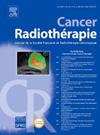Long-term outcomes of radiotherapy and impact of nodal disease burden in clinically node-positive prostate cancer
IF 1.4
4区 医学
Q4 ONCOLOGY
引用次数: 0
Abstract
Purpose
The optimal management for pelvic clinical node-positive (cN1) prostate cancer remains controversial and randomized evidence for local therapy is lacking. Recent data suggest that common-iliac nodal metastases might carry a prognosis similar to that of cN1 disease when treated radically. In this context, we retrospectively reviewed the experience at our centre of treating cN1 prostate cancer, with or without common-iliac nodal metastases, focusing on the role of radiotherapy and the effect of nodal disease burden on survival.
Materials and methods
The study population consisted of men diagnosed with prostate cancer between 2002 and 2018 with cN1 disease and/or common-iliac nodal metastases and treated with androgen deprivation therapy and/or definitive local therapy. Outcomes of interest included overall survival and castration resistance-free survival, which were estimated using the Kaplan-Meier method. Univariable and multivariable Cox regression were used to identify factors associated with overall – and castration resistance-free survival. In the subgroup of patients treated with radiation, the association between a number of variables – including biologically effective dose to the prostate, use of elective pelvic nodal radiotherapy, and escalated dose (radiotherapy boost) to positive nodes–and overall survival was studied.
Results
A total of 87 patients were included, of whom 14 had common-iliac nodal metastases and 68 received radiotherapy. Median follow-up was 110 months. On univariate analysis, radiotherapy was associated with improved overall survival (hazard ratio [HR]: 0.28, 95 % confidence interval [CI]: 0.14–0.55, P < 0.0005) and castration resistance-free survival (HR: 0.22, 95 % CI: 0.12–0.41, P < 0.0005). Median overall survival in those patients receiving radiotherapy was 134.9 versus 63.1 months in those not receiving radiotherapy. Receipt of radiotherapy remained significantly associated with overall survival on multivariable analysis (HR: 0.13, 95 % CI: 0.05–0.32, P < 0.001). Biopsy Gleason score 10 and presence of more than two positive lymph nodes were associated with worse overall survival while presence of common-iliac nodal metastases was not found to have any significant association with overall survival. In patients treated with radiation, increasing the biologically effective dose to the prostate was associated with improved overall survival (HR: 0.73 per 10 Gy, 95 % CI: 0.54–0.97, P = 0.03) while use of elective pelvic nodal radiotherapy and use of a radiotherapy boost to positive nodes had no significant association with overall survival.
Conclusion
In this cohort, we evaluate the impact of radiotherapy in pelvic clinical node-positive prostate cancer that includes common-iliac nodal metastases. Receipt of radiotherapy was associated with improved oncologic outcomes. The number of positive pelvic nodes, but not their common-iliac location, was prognostic.
临床淋巴结阳性前列腺癌放疗的长期预后及淋巴结疾病负担的影响
目的盆腔临床淋巴结阳性(cN1)前列腺癌的最佳治疗方法仍存在争议,缺乏局部治疗的随机证据。最近的数据表明,经根治后,髂总淋巴结转移可能具有与cN1疾病相似的预后。在此背景下,我们回顾性回顾了本中心治疗cN1前列腺癌的经验,无论有无髂总淋巴结转移,重点是放疗的作用和淋巴结疾病负担对生存的影响。材料和方法研究人群包括2002年至2018年间诊断为前列腺癌的男性,伴有cN1疾病和/或髂总淋巴结转移,并接受雄激素剥夺治疗和/或明确的局部治疗。结果包括总生存期和无去势阻力生存期,使用Kaplan-Meier方法估计。单变量和多变量Cox回归用于确定与总体和无去势抵抗生存相关的因素。在接受放射治疗的患者亚组中,研究了许多变量之间的关系,包括前列腺的生物有效剂量,选择性盆腔淋巴结放疗的使用,以及向阳性淋巴结升级的剂量(放疗增强)和总生存率。结果共纳入87例患者,其中髂总淋巴结转移14例,放疗68例。中位随访时间为110个月。在单因素分析中,放疗与总生存率的提高相关(风险比[HR]: 0.28, 95%可信区间[CI]: 0.14-0.55, P <;0.0005)和无去势阻力生存率(HR: 0.22, 95% CI: 0.12-0.41, P <;0.0005)。接受放疗的患者中位总生存期为134.9个月,而未接受放疗的患者中位总生存期为63.1个月。多变量分析显示,接受放疗仍与总生存率显著相关(HR: 0.13, 95% CI: 0.05-0.32, P <;0.001)。活检Gleason评分10分和存在两个以上阳性淋巴结与较差的总生存期相关,而髂总淋巴结转移的存在与总生存期没有任何显著关联。在接受放射治疗的患者中,增加前列腺的生物有效剂量与总生存期的改善相关(HR: 0.73 / 10 Gy, 95% CI: 0.54-0.97, P = 0.03),而使用选择性盆腔淋巴结放疗和使用放疗增强阳性淋巴结与总生存期无显著相关性。结论在这个队列中,我们评估了放疗对骨盆临床淋巴结阳性前列腺癌包括髂总淋巴结转移的影响。接受放射治疗与肿瘤预后改善相关。阳性盆腔淋巴结的数目对预后有影响,但对其在髂总位置没有影响。
本文章由计算机程序翻译,如有差异,请以英文原文为准。
求助全文
约1分钟内获得全文
求助全文
来源期刊

Cancer Radiotherapie
医学-核医学
CiteScore
2.20
自引率
23.10%
发文量
129
审稿时长
63 days
期刊介绍:
Cancer/radiothérapie se veut d''abord et avant tout un organe francophone de publication des travaux de recherche en radiothérapie. La revue a pour objectif de diffuser les informations majeures sur les travaux de recherche en cancérologie et tout ce qui touche de près ou de loin au traitement du cancer par les radiations : technologie, radiophysique, radiobiologie et radiothérapie clinique.
 求助内容:
求助内容: 应助结果提醒方式:
应助结果提醒方式:


